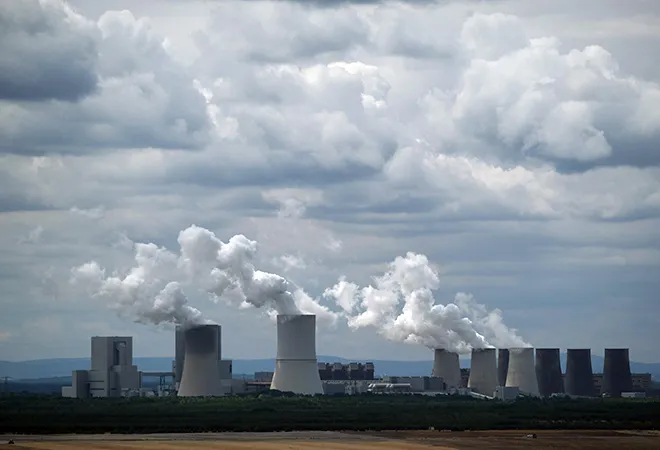
To tackle the rising challenges brought about by climate change, the target of reducing greenhouse gas emissions is as important as ever. The switch from fossil fuels to renewable energy sources has drastically helped reduce carbon emissions in many countries. As such, nuclear energy provides 10 percent of the world’s electricity and is the second largest source of low carbon power in the world. Nuclear energy is essentially produced as a result of “splitting atoms in a reactor to heat water into steam, turn a turbine and generate electricity.” Nuclear energy also has a number of other uses in other sectors such as agriculture, food, medicine, transport, and industry.
Over time, as the world’s energy requirements increase, there is a need to increase energy supply to meet the growing demands, particularly clean energy supplies such as nuclear energy.
Reports from key players in the energy sector discuss the significant role of nuclear-generated power in producing clean electricity. Traditionally, nuclear power is produced from large nuclear power reactors, which has been a major challenge to the large-scale adoption of nuclear energy in the electricity sector across the world.
According to OECD, there is a need to invest in nuclear energy as transitions to clean energy sources will only be more expensive and much tougher with time. Given the world’s electricity requirements, there is a need to invest in nuclear energy as a cleaner energy source.
Nuclear energy is criticised for a number of reasons,
such as exorbitant costs incurred to build the power plant, high maintenance costs, meltdown and safety risks (as seen in the 1986 Chernobyl incident in Russia and the 2011 Fukushima incident in Japan), as well as the risks from nuclear waste. However, according to
a 2019 report by The Organisation for Economic Co-operation and Development (OECD), there is a need to invest in nuclear energy as transitions to clean energy sources will only be more expensive and much tougher with time. Therefore, given the world’s electricity requirements, there is a need to invest in nuclear energy as a cleaner energy source.
Small modular reactors: Concept and benefits
To address these challenges and concerns associated with traditional large-scale nuclear power reactors, small modular reactors (SMRs) present an option for wider use and application for nuclear power generation. The IAEA
defines SMRs as, “advanced nuclear reactors that have a power capacity of up to 300 MW€ per unit, which is about one-third of the generating capacity of traditional nuclear power reactors.” SMRs
are designed using modular factory fabrication technology. The case for SMRs is strengthened by the interest in building smaller units for generating electricity, which address the challenges of traditional larger nuclear power reactors.
Benefits of SMRs can be linked to the nature of their design—small, modular, and capable of harnessing nuclear fission to produce energy. SMRs have displayed flexible power generation options, enhanced inherent safety features, require lesser capital cost, and have a smaller physical footprint than larger traditional nuclear power reactors. They also have a wide range of applications in the electricity sector as well as cogeneration and non-electrical applications. Given their size, SMRs can be located in areas that may not be suitable for traditional, large nuclear power plants. Additionally, the modular aspect of SMRs means that an SMR unit may be manufactured and assembled in factories and then installed at a site as opposed to large power reactors, which are conventionally designed for a specific location.
Benefits of SMRs can be linked to the nature of their design—small, modular, and capable of harnessing nuclear fission to produce energy
Large power reactors, which produce electricity through the steam cycle, require high capital costs. To curb these costs and also meet the need to create smaller easier-to-build electricity grids has led to the shift to build smaller units. Significant
research on SMR technology is underway with large private investment and large global contribution to SMR designs. At present, there
are approximately 70 SMR designs in various developmental stages with some at the near-term deployable stage. The
IAEA has also made efforts to develop SMRs with its member states through a “systematic approach to the identification and development of key enabling technologies, with the goal to achieve competitiveness and reliable performance of such reactors.”
SMRs around the world
Designs for building SMRs are underway in over 17 countries. The global market for SMRs is
projected to reach US $300 billion by 2040. Several countries have SMR designs in various stages of development. However, the move to full scale commercial rollout of SMRs has been a key question in the discussion around the future of nuclear energy and the role of smaller reactors.
The United States (US): The US government has
identified the importance of SMRs in their efforts to develop “safe, clean and affordable nuclear power options”. According to the country’s Nuclear Energy Department, light water-cooled SMRs are under licensing review and will possibly be deployed in the late 2020s/early 2030s. In September 2020, the US Nuclear Regulatory Commission (NRC)
approved NuScale Power’s SMR design, making it the first of its kind SMR to receive the NRC’s approval in the US. The NuScale SMR is an advanced light-water SMR with the capacity to generate 60 MWe and is about one-third of a large-scale nuclear reactor. The reactor is expected to be located at the Idaho National Laboratory and operations are to begin in 2029. NRC is also
in the process of reviewing the US’ first boiling water SMR design.
Canada: In addition to the US, Canada has emphasised the role of SMRs in the country’s nuclear sector. In 2018, Canada’s
NRCan brought together key stakeholders across the country to discuss and build an extensive Roadmap for SMRs in Canada. In December 2020, the government, with its partners, launched an
action plan for SMRs to actualise SMRs in the country. Notably, Canada’s Global First Power
has applied for a license for its Micro Modular Reactor with the Canadian Nuclear Safety Commission (CNSC). This would be Canada’s first SMR with operations slated to begin around 2026.
United Kingdom (UK): In November 2021, the United Kingdom (UK) government
announced its commitment of around £210 million for the development of the Rolls-Royce SMR, which has been matched by private investment of over £250 million. Rolls-Royce
intends to build a 470MWe SMR with availability to the UK electricity grids by the early 2030s.
The US government has identified the importance of SMRs in their efforts to develop “safe, clean and affordable nuclear power options”. According to the country’s Nuclear Energy Department, light water-cooled SMRs are under licensing review and will possibly be deployed in the late 2020s/early 2030s.
Russia: Russia’s Akademik Lomonosov floating nuclear power plant completed a year of operation in May 2021. Russia’s nuclear corporation, Rosatom is
working on the future site of an SMR in far-eastern Siberia, which is expected to be completed by 2028. This plant will include the RITM-200 reactor, which is a 50MWe unit, new-generation nuclear icebreaker.
China: Most recently, and notably, China
became the world’s first country with a small modular nuclear reactor in 2021. The country announced the starting of the Huaneng Group Co.’s 200MW unite 1 reactor at Shidao Bay. The SMR is nearly one-fifth the size of China’s first homegrown nuclear reactor design, Hualong One. Additionally, it has been
estimated that China intends to invest around US $440 billion in nuclear power over the next 40 years.
Other countries: Argentina is in an
advanced stage of construction of the 27MW Argentine CAREM. The US’ NuScale has signed agreements to build SMRS in Canada, Romania, the Czech Republic, and Jordan.
Challenges
Although SMRs present great opportunity for the nuclear energy industry, they do not exist without their own set of challenges. First, there is the
issue of overabundance of reactor design choice. Large-scale development and deployment of SMRs is predicated upon the ability to reach some sort of consensus on what kind of SMR technology is ideal and capable of achieving large-scale commercial rollout. Second, SMR technologies are
impacted by licensing challenges, similar to large-scale reactors. SMR technology does not necessarily fit into existing licensing processes and the relatively newness of the reactor designs poses a challenge to the licensing and regulation of SMR designs and units. The process for licensing of designs, construction, and operation is not necessarily
shorter than that of larger reactors. Additionally, the process of
site selection for SMR units must be streamlined to determine the possibility of accelerated implementation of SMR units. Although SMR’s
initial cost is low, the economic viability once deployed is yet to be determined.
Conclusion
Given the opportunities SMRs present, there is a need to push for SMR technologies as a viable nuclear energy option to meet both the growing global energy needs and the search for low-carbon energy options. In comparison to large-scale nuclear power reactors, SMR technology provide a simpler and inherently safer opportunity for the expansion of the nuclear energy sector. SMRs have lesser fuel requirements, smaller physical area requirements and hold the potential for large-scale factory production, transportation, and installation globally. Given the interest and active participation from both the public and private sectors in countries such as Argentina, Canada, China, Russia, United Kingdom, United States, and South Korea in SMRs, the future of nuclear power as a viable energy alternative is predicated upon actualising the SMR technology potential at a global level. To achieve the Sustainable Development Goal of universal access to energy (
SDG 7), SMRs and nuclear power offer more efficiency and flexibility to meet energy demands than other renewables alternatives such as wind and solar.
The views expressed above belong to the author(s). ORF research and analyses now available on Telegram! Click here to access our curated content — blogs, longforms and interviews.




 PREV
PREV


